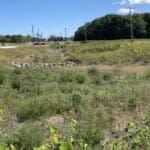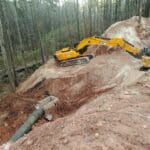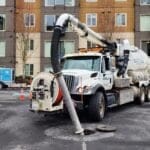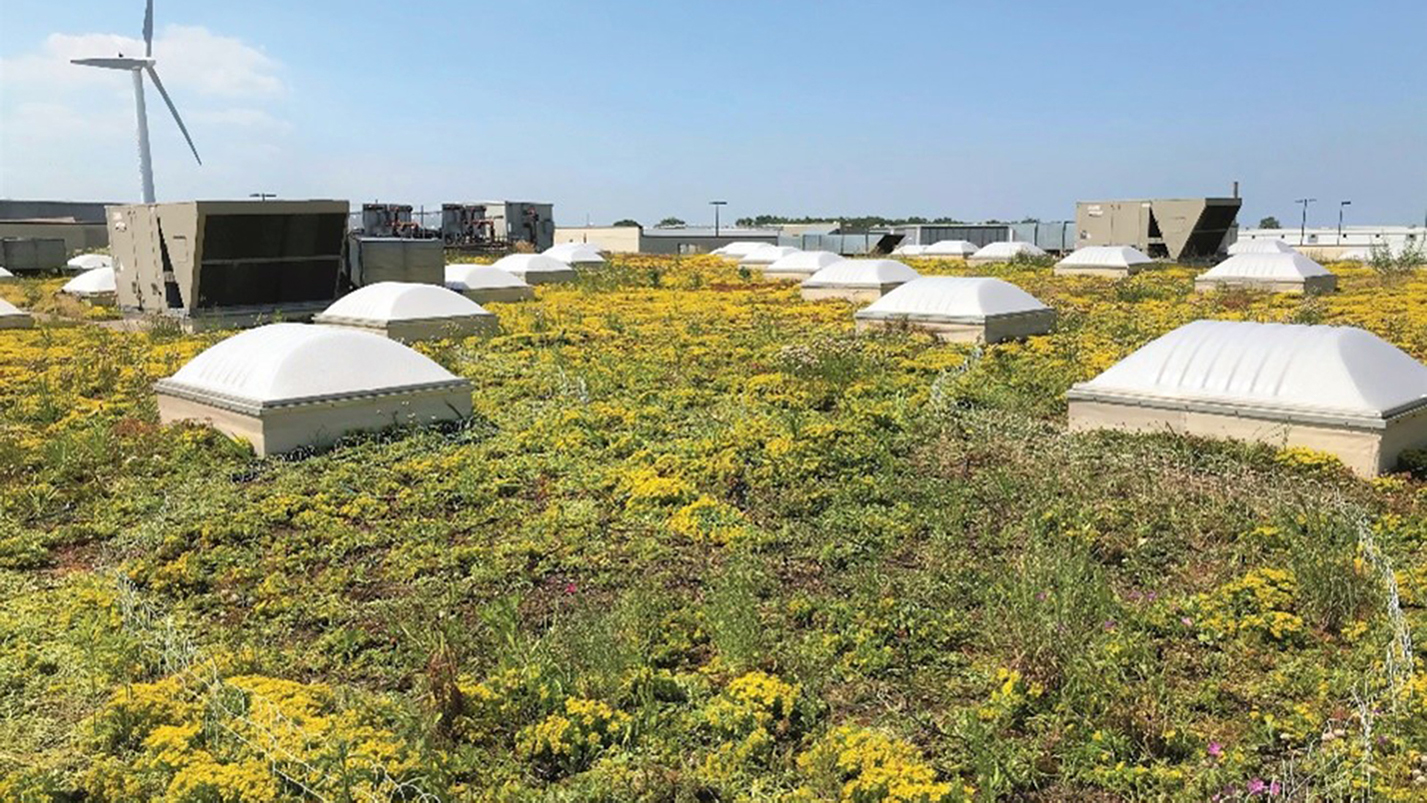City of Warwick
The EPA’s Storm Water Phase II Rule of 1999 requires operators of municipal separate storm sewer systems (MS4s) to obtain permits and establish a stormwater management program that is intended to improve waterbodies by reducing the quantity of pollutants that can enter storm sewer systems during storm events. As it is classified as a regulated Small MS4 Operator, the City of Warwick must apply for a Rhode Island Pollutant discharge Elimination System (RIPDES) permit and develop a Storm Water Management Program Plan (SWMPP) describing the Best Management Practices (BMPs) to be implemented in the six minimum measure areas.
The SWMPP for Small MS4 Operators must contain the measurable goals for each minimum control measure as well as an implementation schedule including interim milestones and frequency of activities and reporting of results. Additional permit requirements may also be required of MS4 operators based on total maximum daily load (TMDL) restrictions placed on impaired waterbodies. The City of Warwick has approved a comprehensive plan that includes stormwater management goals to be attained in the very near future.
City of Warwick Comprehensive Plan
CHAPTER 3 DEVELOPMENT STRATEGY AND IMPLEMENTATION PROGRAM
Stormwater Management
- Develop a municipal stormwater drainage management plan.
- Require stormwater drainage management planning and design for all new or expanded commercial, industrial, or multiple lot residential development.
- Require on-site stormwater management for new and expanding development with the goals of achieving a zero net increase in stormwater runoff and to protect and where possible improve the quality of the receiving waterbody.
- Require the implementation of Erosion and Sedimentation Controls on all development including the development of single family residences and the development of individual lots to prevent adverse erosion and sedimentation impacts on abutting properties, natural resources, the municipal drainage system, and stormwater retention and detention basins.
- Provide the building inspectors office with an Erosion and Sedimentation Control inspector to enforce the Erosion and Sedimentation Control Plan.
- Develop intermunicipal agreements where appropriate to control stormwater runoff from and to adjacent communities.
- Develop an agreement with the Rhode Island Department of Environmental Management to enable the city to provide timely and reasonable maintenance of existing drainage facilities, including stormwater detention/retention basins and natural drainageways.
- Continue implementation of the Department of Public Works neighborhood drainage improvement program.
- Assure proper maintenance of privately owned drainage systems, especially drainage detention/retention basins, by assigning responsibilities during the process of project approval.
- Within the context of water quality management and the proposed municipal stormwater drainage management plan consider the need and alternatives for retrofitting water quality improvement techniques into existing older drainage systems and into areas with no water quality impact mitigation features.
- Develop and install water quality impact mitigation techniques for drainage systems discharging into Gorton’s Pond and other environmentally sensitive water bodies.
Public Facilities and Services
- Continue to protect existing and potential drinking water sources and to implement water system management and capital plans.
- Continue to implement plans and programs to protect the Wastewater Treatment Facility from flooding.
- Continue eliminating all cesspools and implementing the Mandatory Sewer Connection Program.
- Comply with state and federal stormwater management requirements and best practices for drainage.
- Ensure that all private developments adhere to the standards in the state stormwater design manual.
- Invest in a GIS system and an asset management system to manage city-owned property efficiently.
- Continue improving the city website to be more informative and user-friendly.
Depending on the location and nature of the activity, private and public entities wishing to construct new developments or redevelopments in the State of Rhode Island must prepare and implement a Stormwater Management Plan in accordance with the recently issued Rhode Island Stormwater Design and Installation Standards Manual (RIDEM & CRMC, 2010)18 as a component of required regulatory approvals from the CRMC (Coastal Assent) and/or RIDEM (e.g., Freshwater Wetlands Program, Underground Injection Control Program, Water Quality Certification). Policies set forth in the manual require that the Stormwater Management Plan and site design mitigate the potential for adverse water quality and quantity (flooding, erosion) impacts to receiving waters through application of the following minimum stormwater management standards (where applicable):
- Low Impact Development (LID) Planning and Design Strategies
- Groundwater Recharge
- Water Quality Protection Measures
- Conveyance and Natural Channel Protection
- Overbank Flood Protection
- Redevelopment and Infill Projects (Alternative Requirements)
- Pollution Prevention
- Mitigation of Land Uses with Higher Potential Pollutant Loads (LUHPPLs)
- Illicit Discharge Detection and Elimination
- Construction Erosion and Sedimentation Control
- Stormwater Management System Operation and Maintenance
The stormwater manual also sets forth standards, policies, and design guidance for structural BMPs (Best Management Practices), such as retention/detention basins that may be employed to meet water quality and quantity control criteria. Additionally, proposed development projects involving land disturbances greater than one acre must seek coverage under the RIPDES General Permit for Storm Water Discharge Associated with Construction Activity. Conditions of the permit require that the proponent fi le a Notice of Intent (NOI) with the RIPDES Program and prepare a Construction Site Storm Water Pollution Prevention Plan (SWPPP), a working document that describes the erosion and sediment control measures and pollution prevention techniques that will be employed during an active construction project.
EXISTING SURFACE DRAINAGE AND INFRASTRUCTURE
A multitude of publicly and privately owned drainage systems convey surface runoff to receiving waterbodies/watercourses within Warwick. The drainage network includes open (drainage swales, channels) and closed (catch basins, drainage manholes, and piping systems) elements, as well as include BMPs such as detention basins, wet swales, and/or hydrodynamic separators. In general, structures and systems located within the public right-of-way are owned and maintained by either the City of Warwick or the State Department of Transportation. It is also not uncommon for systems operated by the city to be interconnected with those of the RIDOT at various locations.
The Greenwich Bay Special Area Management Plan (SAMP, 2005)20 makes stormwater management recommendations which are largely identical to the requirements of MS4 Operators under the RIPDES Program, including the mapping stormwater outfalls; identifying, eliminating and preventing illicit discharges; planning and implementing structural BMPs to improve water quality and reduce runoff; and updating municipal ordinances to enforce proper stormwater management. Amongst these recommendations, the SAMP also specifically recommends that:
Warwick should conduct BMP feasibility studies to identify locations for installing stormwater BMPs in the Greenwich Bay watershed that address bacteria and nitrogen concentrations as well as stormwater volume, once such BMPs are identified by CRMC and RIDEM.
The draft TMDL identifies Brush Neck Cove and Apponaug Cove as priority areas for Warwick (RIDEM, 2004a). BMP feasibility studies should include outfalls with large impervious drainage areas, the outfalls prioritized by SRICD, and the direct storm water discharges identified by URI-CVE22 as large bacteria loads to Greenwich Bay. While physical constraints at these locations may exist, they should be considered first for BMP construction. (§470.5B.13)
MUNICIPAL MANAGEMENT AND COMPLIANCE
In 2008 the City of Warwick commissioned the preparation of its SWMPP to comply with RIPDES requirements, which included sections addressing resource protection (identification of impaired waters and critical habitats), existing drainage systems (sub-watershed descriptions), and the six minimum control measures described in Table 10.6 (including mechanisms and timeframes for implementation). Although the SWMPP has been completed, the City of Warwick is currently in receipt of a Notice of Noncompliance from the RIDEM for not satisfactorily addressing the requirements of its RIPDES MS4 Permit (#RIR040031), including failure to submit annual reports documenting compliance and progress towards achieving SWMPP goals in the six minimum measures required of all MS4 operators.
Largely due to a lack of available funding and resources (coupled with the sheer area and extensive stormwater infrastructure throughout the city), the City of Warwick has to date been unable to complete the most labor-intensive elements required under its RIPDES permit:
Mapping of all stormwater outfalls. Outfall sampling is required under the Illicit Discharge Detection and Elimination minimum measure. Updating of city ordinances (e.g., Soil Erosion and Sediment Control) for consistency with current best practices. Although the city effectively meets certain requirements through completed or continuing efforts (such as storm drain stenciling, annual street sweeping and catch basin cleaning), it is imperative that the city renew its commitment to the RIPDES MS4 program to avoid the assessment of fines for noncompliance and to meet the stormwater management goals and policies of the preceding planning period, on which limited headway has been made to date.
Needs
The City of Warwick Stormwater Management Program Plan identifies the following future priority needs:
- Continue to develop outreach strategies and partnership arrangements and expand the city website to provide educational information and encourage involvement with the storm water program.
- Continue implementing the CRMC Special Area Management Plan for Greenwich Bay.
- Inspect City discharges and conduct dry-weather surveys as required.
- Review all construction project plans and SWPPPs for construction projects within the regulated area.
- Track all Building Permits and Planning Review Applications.
- Complete inspections for all construction projects within the regulated area that discharge or have the potential to discharge to the MS4.
- Develop an operations and maintenance program for BMPs, storm sewers, and catch basins.
- Conduct inspections on all BMPs, storm sewers, catch basins and clean as required.
- Sweep all roads annually.
- Sweep critical environmentally sensitive areas twice per year.
- Conduct outfall and erosion control inspections, as required.
City of Warwick Comprehensive Plan: Approved
The City of Warwick now has a policy of zero net increase in runoff from new development. Zero net increase means that the rate and volume of runoff from a site that is newly developed cannot exceed the rate and volume of runoff from the site before it was developed. To accomplish the objective of zero net increase in runoff, developers are required to construct stormwater management facilities that will collect and detain the flows of stormwater. These facilities typically include surface detention basins which collect runoff and meter it out into drainage ways and streams at rates that do not exceed preconstruction conditions. From a water quality perspective, drainage detention basins are important facilities for the removal of surface runoff pollutants. The Department of Public Works City Engineering Office maintains a list of all existing and proposed detention basins constructed in the City, and there currently are 45 such structures either in operation or in design. It is the City’s policy that these basins be fenced if there will be more than two feet of standing water in the basin after a storm. The Town Engineer is primarily responsible for overseeing roadway and drainage projects and maintenance, including design, bidding and construction management. In addition, the Town Engineer issues and administers permits to private contractors for road, curbing and sidewalk work within Town rights-of-way.
Facility Maintenance and Improvements
The Department of Public Works implements a maintenance program that cleans existing manholes and catch basins on an annual basis. There are three men assigned to perform this work and to construct drainage improvements. The priorities for improvements are established through the review and analysis of drainage problems by the Director of Public Works and the City Engineer and are based on the following factors:
- Threat to public safety such as icing or severe ponding so as to cause traffic accidents;
- Threat to public health such as through basement flooding so as to contribute to disease, fire, electric shock, or other injurious events;
- Threat to property such as through flooding of yards and dwellings resulting in damage or loss of personal and real property;
- Adverse impacts on aesthetics such as severe ponding and puddling of muddy water and debris;
- General nuisance such as slow draining systems; and
- Volume and frequency of complaints.
Information on drainage problems is collected through resident’s complaints, first hand observation by the City Engineer’s office, and occasionally through neighborhood questionnaires developed by the City Engineer’s office. The Department of Public Works and the City Engineering staff survey the City’s streets and records the general condition of the pavement and the drainage systems. This information is utilized along with that collected for specific problems and utilized to prepare the Capital Improvement Program.
Record keeping is extensive at the City Engineer’s office and consists of street maps, subdivision plans, plat and lot maps, card files on every street and computerized data. Not all of the information on the municipal infrastructure is computerized nor is there a computerized map base. There is no master plan for drainage system improvements in the City. Information obtained through interviews with City Engineering personnel highlight the following areas and drainage problems in Warwick:
- Greenwood – inadequate collection system.
- Gaspee and Governor Francis Farms – lack of collection systems, failing subsurface drains and high groundwater problems;
- Cowesett – lack of collection systems, high groundwater problems, and unmanaged stormwater runoff into Hardig Brook;
- Pontiac – unmanaged stormwater runoff from Cranston;
- Wildes Corner – maintenance of stormwater flows through natural drainage areas;
- Hoxsie/Old Warwick – maintenance of stormwater flows through natural drainage areas and high groundwater;
- Warwick Neck – high groundwater;
- Norwood – inadequate collection system.
Drainage retention basins are a relatively new phenomenon in the City of Warwick. As collection and temporary impoundment sites for large volumes of water, these structures become vegetated with wetland plant species and develop wetland habitat values. They also collect sand, silt, trash and debris and over time may become choked with vegetative growth and organic debris similar to the way mosquito ditches become clogged. The basins also can become mosquito breeding areas if they do not drain properly between storms. The City has ownership and control over the basins constructed as part of residential subdivisions while basins associated with commercial sites are controlled by the owner. Because these basins can develop wetland values, their maintenance may be complicated by regulation by the Rhode Island Department of Environmental Management and the Army Corps of Engineers.
The Department of Public Works at one time maintained a special crew of employees whose responsibility it was to keep the natural drainage ways and brooks clear of excess vegetation and debris to enhance stormwater flows. This was especially important since developing neighborhoods of the city discharged their drainage into these brooks and streams. Maintenance of these natural features has not kept pace with the need, and the Wetlands and Coastal Resources Management Program elaborate and lengthy permit processes are viewed as impediments to the proper maintenance of natural systems that have historically been relied on as drainage ways. These permit processes also regulate the maintenance of manmade structures associated with the natural drainage ways.
Maintenance of the city drainage systems constitutes a significant portion of the budget for Warwick. The annual operating budget for this work is $100,000. In addition to this, in 1989, a bond referendum was approved by the voters for $1.5 million in local street and drainage improvements. The City’s 1991-2006 Capital Improvements Program for drainage improvements through 1993 is presented in Table 3. This work often occurs in conjunction with maintenance and repair of city streets also performed by the Department of Public Works.
Warwick, RI Stormwater Documents:

 Kenosha, Wis. Highway KR Regenerative Stormwater ConveyanceThe Root-Pike Watershed Initiative Network Kenosha County, and others worked with AQUALIS to design and implement an innovative solution for stormwater control along Highway KR.
Kenosha, Wis. Highway KR Regenerative Stormwater ConveyanceThe Root-Pike Watershed Initiative Network Kenosha County, and others worked with AQUALIS to design and implement an innovative solution for stormwater control along Highway KR. Durham, N.C. Sinkhole Leads to Stormwater System RehabilitationThe tenant on this property noticed a depression that opened to the ground below and notified the property owners.
Durham, N.C. Sinkhole Leads to Stormwater System RehabilitationThe tenant on this property noticed a depression that opened to the ground below and notified the property owners.

